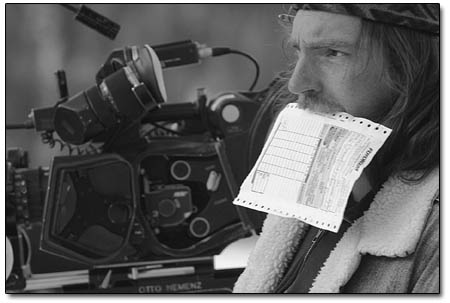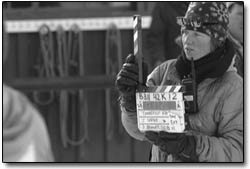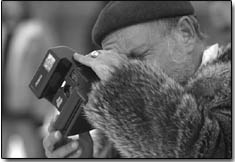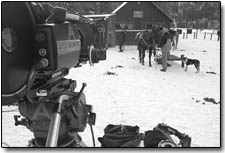|
Crew films "Connecticut Kid"
at Vallecito ranch
by Jen Reeder
 |
| 1st Assistant Cameraman
Nick Neino watches the actors on set as he prepares
for the next take./Photo by Todd Newcomer. |
The ground is covered with snow at a working ranch in
Vallecito. Several film cameras are directed at a corral,
where horses and actors mill around, waiting for someone
to yell “Action!”
The moment approaches.
“Everybody stand by...everybody quiet please...”
Just then, as if on cue, a horse farts and begins a mighty
bowel movement.
It was Dec. 12, a few days before wrapping on the set
of “The Connecticut Kid,” an independent film
eight years in the making – well, eight years of
looking for financing, at any rate.
 |
| Kitta Larsen prepares to document
a scene and snap the slate shut during shooting Friday
at Wilderness Trails Ranch./Photo by Todd Newcomer |
The film is based on the experiences of writer/director/star
Jack Serino, who worked at the Wilderness Trails Ranch
– where the movie was filmed – for a summer
when he was 20 years old. In the film, Serino, now in
his early thirties, plays a city slicker from Connecticut
who gets a hard time from the ranch hands but eventually
“saves the day and wrangles the horses when they
start running around,” according to a crew member.
“Don’t let him tell you it’s a true
story,” says Lance Roberts, an owner of the ranch,
with a sideways glance.
Because of the film’s tight budget, Roberts and
many crew members were drafted to act in the film.
“Everybody’s doing four jobs – it’s
a pretty small crew,” said Michael Black, 2nd unit
director of photography. “It’s funny because
most of the crew is acting as well. They’re doing
a good job, but it leaves us short on crew for some scenes.”
Crew members’ dedication is evidenced by the long
hours and cuts in pay they took in making the film. For
most, working on the film is a favor to Serino, who works
in the Los Angeles film industry as an art director. The
cast and crew members are coworkers and friends, and his
best friend, Jim Rosenthal, is producing it.
 |
Art Director Gyll Huff snaps a Polaroid
of an actor’s costume so it can be accurately
duplicated in later scenes./Photo
by Todd Newcomer. |
Rosenthal said he first read the script eight years ago
and has wanted to make the film ever since. He was producing
a film in Salt Lake City, where he often works despite
living in LA, when he got the long-awaited call from Serino.
“Jack called and said, ‘I think we found
the money,’” Rosenthal said. “I called
all our friends and said, ‘Come help us out –
this has been Jack’s dream forever.’”
The friends came through, and the first meeting for
the film took place Thanksgiving Day at Denny’s
in Durango. Just a few weeks later, the film was in full
swing.
Today, after setting up a shot, Serino changes hats
– falling off a horse onto a pile of mattresses.
He stays on the ground even after someone yells, “Cut!”
“Jack, are you alright?” People start yelling.
“Is it your shoulder? Jack?”
He pops up and grins.“Was that good?” he
teases.
But the crew has reason for concern: The one major mishap
of the film occurred when Serino “took a big header
off a horse and the horse just wouldn’t stop,”
Rosenthal recounts. “I’m not sure if Jack
would want that mentioned.”
But then he calls over a red-headed woman and announces,
“She’s the one who saved Jack!”
The redhead is Amanda Williamson, a Vallecito local
who has worked at Wilderness Trails Ranch for seven years.
The crew met her at Virginia’s – where it
hangs out every night – and promptly cast her.
“They needed a wrangler named Red, and here I
am!” she laughs as she throws her hands in the air.
Incidentally, her dog “Rowdy” also was cast
in the film, though his stage name is “Killer.”
 |
A camera sits unmanned as the crew
prepares the set for the next scene. /Photo
by Todd Newcomer. |
Rosenthal says that half the crew is staying in cabins
at Virginia’s, likes the restaurant’s food
and is especially fond of the pay phone, since cell phones
don’t work at Wilderness Trails Ranch. “At
the end of work we go to Virginia’s, and we all
fight for the pay phone, our link to civilization,”
he says.
And the business is great for Virginia’s Steak
House.
“It gives a little economic boost – we’re
glad to have them,” says owner Steve Dudley. “They’re
all young or middle-aged and have a lot of energy.You
can tell they’re working their buns off.”
And apparently they are – Rosenthal says the crew
works from 6 a.m. to 7 p.m. each day, and has had only
one day off in 14 days of filming. Everyone – aside
from production assistants, the indentured servants of
the film industry – is paid the same amount each
day: $100, approximately four times less than normal.
“I just promise them three meals a day and lots
of beer,” Rosenthal says fondly.
And aside from a couple of trucks getting stuck in the
snow, and “city kids getting horse bites,”
filming has been relatively smooth and the friendships
are intact, Rosenthal says.
“We all sort of grew up together in the film business,”
he says. And they have high hopes for what he describes
as “a wholesome little family movie about a guy
living out his dreams.”
|

